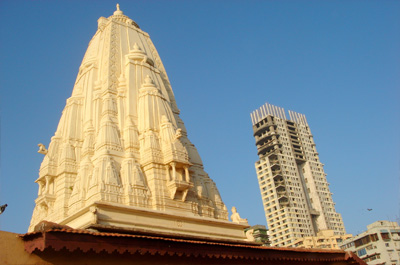Places of Worship Mumbai

Mumba Devi Temple, Mumbai
Mumba Devi or Mumba Aai is the patron goddess of the Kolis, the original habitant of Mumbai. It is because of her name the seven islands of Mumbai were collectively called Mumbyin. It was only in the 18th century that the name Bombay became popular and was used for all practical purpose.
The temple of Mumbadevi was originally situated at the Phansi Talao, a place where the complex of Victoria Terminus (C.S.T.) is now located. Near the temple was a small pond. The temple was moved to Kalbadevi precinct in or about 1737. The original idol was installed there along with that of Annapurna and a beautiful temple was built by a devotee named Pandurang Shivaji, a goldsmith. The tank in the present precinct was built later on in 1830. According to the old record a woman named Putalabai, who belonged to Baniya community, spent for the construction work. Mumba Devi is believed to be a symbol of the Mother Earth, the Jaganmata.
Bhuleshwar Temple, Mumbai
This is one of the famous old temple in Mumbai. It was built in 1708 by a wealthy and generous devotee from Prabhu community named Dadaji Laxajirao. The temple has a spacious expanse and shows prominent signs of Gujarati style of architecture in its design and construction. At the entrance of this Shiva Temple is a Nagarkhana (drum room). Wood used for it is beautifully carved. The temple also has a spacious Sabha Mandap, a conference hall, hwere the devotees assemble for worship and darshan.
Surya Narayan Temple, Mumbai
It is a beautiful temple of Sun God, built in 1899, at Suraj Wadi near the Bhuleshwar Temple. The temple is constructed of white stone. At the entrance of the temple are carved figures of Jaya and Vijaya, the divine gatekeepers of God. On its stone pillars are carved sculptures of Sapta Rishi-the sages. There are sculptures of Maruti, Ganesh and Apsaras also, all carved in marble stone.
The Sun God , wearing a crown, is seated on a chariot and his two wives Prabha and Chhaya are on his either side. The chariot is drawn by a horse with seven heads.
Walkeshwar Temple and Banganga, Mumbai
The Walkeshwar temple at the bank of Banganga Lake on Malabar Hill was originally built by the Shilahara, who ruled the islands of Mumbai during 810 to 1260 A.D. The Bangaga Lake is formed by an underground spring which flows naturally within.
The legend goes that Lord Rama, while in exile, was wandering in search of Sita. He stopped here on his way to Lanks for daily rituals. He prepared a Lingam from the sands of sea and worshipped it. The place is called therfore Walukeshwar. As there was no water to be found for drinking, Rama pierced his arrow into the earth down to the Patal and a spring of water shot out instantly and formed the lake. The lake is, since the, came to be known as Banaganga.
The place, because of this legend, has become a holy place for pilgrimage. The precinct had few small temples in the vicinity of Walukeshwar Temple which were built later on. But the area now has become highly developed and considered to be an affluent one. Due to the sanctity of the Banganga water, people still perform various religious rites here with this sacred water, especially on Shivratri.
The original temple of Walukeshwar was destroyed by the Portuguese but was rebuilt in 1715 by a devotee named Ram Kamat.
The State Government, in recent years, has been organising Music Festival here regularly in every winter. The entire precinct is illuminated richly during his festival.
Babulnath Temple, Mumbai
It is an old temple of Shiva where devotees throng for darshan on Mondays. Shivratri and other festivals. The temple is built in 1780 and is located at the south of Malabar Hill. The Shiva Linga in this temple is unique and monolithic.
Mahalaxmi Temple, Mumbai
This is one of the old and most famous temple in Mumbai. The temple stands in the north of Malabar Hill, near Worli sea-shore. Three idols of goddesses namely Mahalaxmi Mahakali and Mahasaraswati are installed in this temple. Devotees throng here on Tuesdays, Fridays, and also during the Navratri festival.
According to the old records the original temple of Mahalaxmi was as old as that of Walukeshwar. But the temple was demolised and destroyed by the Muslim envaders in medieval period.
According to a legend the alive deities disappeared into the sea at the time of invasion and were found by an engineer after a long search in the sea at Worli. The knowledgeable sources say that the engineer from the Prabhu Community, who was incharge of the linkage work between Malabar Hill and Worli, undertaken during the tenure of William Hornbey, was very much disappointed due to his failure in the work he undertook. The work of constructing rampart was not coming up in any case. It used to slide down again and again. One day, as he was worried about his failure, he had a vision of the three goddesses in a dream. The goddesses asked him to pick up their idols lying at the sea bottom at Worli and build a temple for them. They also graced him for success in the construction work. The engineer accordingly made a search for these idols and found them at Worli Sea. He brought them out and installed them for the time being at a place where the temple at present is located. The engineer completed the entire construction work, without any failure. He then acquired a vast piece of land in the same vicinity and built a spacious temple for the salvaged idols. The temple stands at the place for more than 100 years with a glorious past and mystic legendary.







